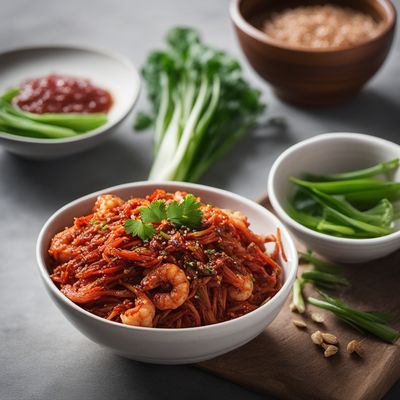
Recipe
Bavarian-style Kimchi
Bavarian Sauerkraut with a Korean Twist
4.8 out of 5
In the context of Bavarian cuisine, we are adapting the traditional Korean dish of Kimchi to create a unique fusion of flavors. This Bavarian-style Kimchi combines the tangy and spicy elements of Kimchi with the rich and hearty flavors of Bavarian cuisine, resulting in a delicious and innovative dish.
Metadata
Preparation time
20 minutes
Cooking time
0 minutes (fermentation time: 3-5 days)
Total time
3-5 days (including fermentation and chilling time)
Yields
4 servings
Preparation difficulty
Easy
Suitable for
Vegetarian, Vegan, Gluten-free, Dairy-free, Low calorie
Allergens
Mustard, Soy
Not suitable for
Paleo, Keto, Low-carb, Nut-free, Soy-free
Ingredients
While the original Korean Kimchi is made primarily with Napa cabbage, our Bavarian-style Kimchi incorporates traditional Bavarian sauerkraut as the base. We also add German mustard and beer to enhance the flavors and give it a distinct Bavarian twist. We alse have the original recipe for Kimchi, so you can check it out.
-
1 head of sauerkraut (500g / 1.1lb) 1 head of sauerkraut (500g / 1.1lb)
-
2 tablespoons Korean red pepper flakes (Gochugaru) 2 tablespoons Korean red pepper flakes (Gochugaru)
-
2 tablespoons German mustard 2 tablespoons German mustard
-
1 tablespoon soy sauce 1 tablespoon soy sauce
-
1 tablespoon honey 1 tablespoon honey
-
2 cloves garlic, minced 2 cloves garlic, minced
-
1 small onion, finely chopped 1 small onion, finely chopped
-
1 tablespoon ginger, grated 1 tablespoon ginger, grated
-
1 tablespoon caraway seeds 1 tablespoon caraway seeds
-
1 cup German beer (235ml) 1 cup German beer (235ml)
-
Salt, to taste Salt, to taste
Nutrition
- Calories (kcal / KJ): 80 kcal / 335 KJ
- Fat (total, saturated): 0g, 0g
- Carbohydrates (total, sugars): 20g, 10g
- Protein: 2g
- Fiber: 5g
- Salt: 1g
Preparation
-
1.Rinse the sauerkraut under cold water to remove excess brine. Squeeze out any excess liquid and set aside.
-
2.In a large bowl, combine the Korean red pepper flakes, German mustard, soy sauce, honey, minced garlic, chopped onion, grated ginger, and caraway seeds.
-
3.Add the sauerkraut to the bowl and mix well, ensuring the sauce is evenly distributed.
-
4.Transfer the mixture to a sterilized jar or fermentation crock.
-
5.Pour the German beer over the sauerkraut mixture, ensuring it is fully submerged.
-
6.Cover the jar or crock with a clean cloth or lid, and let it ferment at room temperature for 3-5 days, depending on your desired level of fermentation.
-
7.Once fermented, transfer the Bavarian-style Kimchi to the refrigerator and let it chill for at least 24 hours before serving.
-
8.Serve as a side dish or condiment with Bavarian dishes.
Treat your ingredients with care...
- Sauerkraut — Rinse the sauerkraut to reduce its sourness and adjust the saltiness to your taste.
- Korean red pepper flakes (Gochugaru) — Adjust the amount according to your preferred level of spiciness.
- German mustard — Use a good quality German mustard for authentic Bavarian flavors.
- German beer — Choose a light or medium-bodied German beer to complement the flavors of the Kimchi.
- Caraway seeds — Toast the caraway seeds in a dry pan before adding them to the mixture for enhanced aroma.
Tips & Tricks
- For a milder flavor, reduce the amount of Korean red pepper flakes.
- Adjust the fermentation time based on your preference for tanginess.
- Serve the Bavarian-style Kimchi with traditional Bavarian sausages or roasted meats.
- Experiment with adding other Bavarian ingredients like apples or juniper berries for additional flavors.
- Store the Kimchi in airtight containers to prevent it from absorbing other odors in the refrigerator.
Serving advice
Serve the Bavarian-style Kimchi as a side dish alongside traditional Bavarian dishes such as pretzels, sausages, or roasted pork. It can also be enjoyed as a condiment to add a tangy and spicy kick to sandwiches or burgers.
Presentation advice
Present the Bavarian-style Kimchi in a small bowl or on a platter, garnished with fresh herbs like parsley or chives. The vibrant red color of the Kimchi will add a pop of color to your table.
More recipes...
For Kimchi » Browse all
For Korean cuisine » Browse all
More Korean cuisine dishes » Browse all

Oiseon
Stuffed Cucumber
Oiseon is a Korean dish made with thinly sliced beef and vegetables.

Chamchijeon
Tuna Pancake
Chamchijeon is a Korean dish made with canned tuna that is mixed with flour and egg and pan-fried.

Bukkumi
Bukkumi is a traditional Korean dessert made with glutinous rice flour and sweet red bean paste. It is a popular snack during festivals and...











